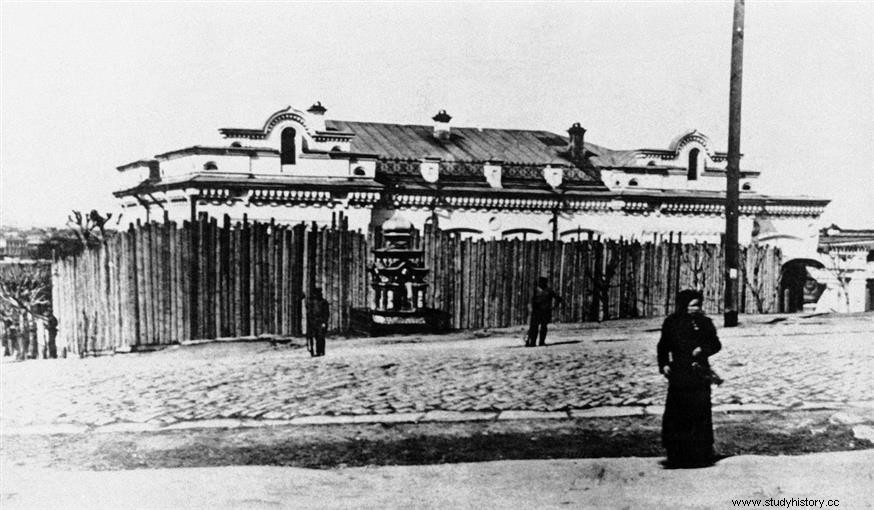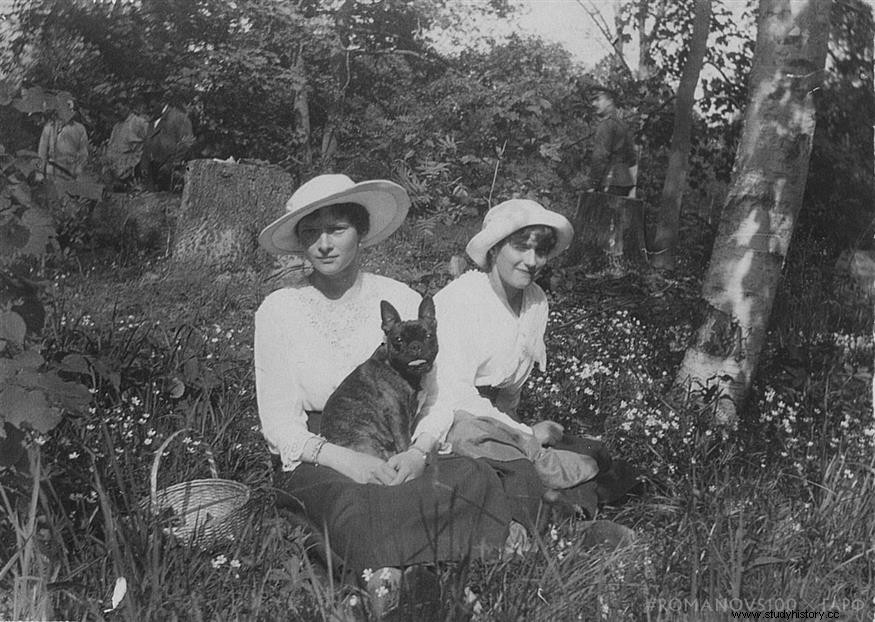It was a day like today , July 17, 1918, when the entire tsarist Romanov family is mercilessly massacred by the Bolsheviks. Not even their dogs survived... except one!
The Bolshevik Revolution Overthrew the Russian Empire and the rule of the Romanov family, opening a whole new chapter in History .
When the Bolsheviks seized power Tsar Nicholas II he had already resigned; he and his family were arrested and sent into exile.
The Romanovs, in a last-ditch effort to save their lives and fortunes, sought asylum from Nikolaou's cousin, King George V' of England , but the door ofGreat Britain it was... small for the tsarist family to pass through. For reasons of political expediency, the Romanovs were left helpless in the hands of their fate and their executioners.
Happy and carefree
Family members wrote regularly in their diaries, which allows us to imagine their life in exile. Nicholas managed to convince the supervising officer to bring tutors to his children:Grand Duchess Olga (22 years old), Tatiana (21), Maria (19), Anastasia (17) and Tsarevich Alexei (13).
In the evenings , the family would gather in one of the rooms to read and study the Bible. The Romanovs were devout Christians - religious in a word - and when they were in despair, they turned to God.
The Surviving Correspondence between family members is full of tenderness; they gave each other nicknames, shared funny stories about their pets, some of which accompanied them into exile.
Young Alexei was especially fond of his dog Joey , who slipped through a... crevice of fate and survived the Revolution, arrived in England, lived for several years and was buried in the graveyard of Windsor Castle! But people come first. Joey's story below...
The Romanovs were being watched everywhere from the watchful eyes of armed soldiers. Their correspondence was censored and strictly limited. Nevertheless, they never treated their captors as enemies, which is confirmed by their letters.
On December 12, the children's teacher, Pierre Gillard, made an entry in his diary:"The Grand Duchesses, with their charming simplicity, they loved talking to these people. They ask the soldiers about their families or about the battles they took part in during the war. Alexei also won their hearts and they did everything they could to make him happy.”
Besides the lack of fun, there was a much more important factor that made the confinement unbearable. Alexei, the successor of Nicholas II, suffered from hemophilia, a rare genetic disorder in which the blood does not clot normally. This condition can make any injury even fatal and even a small bruise took several days to heal.
Once the situation changed
Life in exile "burdened" when the provisional government assigned a new group of soldiers to replace the guards. That group consisted of former political prisoners and members of anarchist groups that were now the new power structure.
The guards, forced the former Tsar to remove all military insignia and issued numbered identity documents for each family member. Children were no longer allowed to play or use their camera. The Romanovs also met the new commander of the house named Yakov Yurovsky . In Radzinski's biography of Nicholas II we find Yurowski's first impression of the Romanovs:"If it were not for this despicable imperial family, one might consider them simple people without arrogance."
Yurovsky kicked out the royal retinue including Master Gillard and it was then that the Empress began to suspect that something terrible was about to happen.
On the fateful day of July 16, Yurovsky kicked the cook out of the kitchen and Alexandra wrote in her diary :“Lika Sedniev was sent to meet his uncle. I wonder if it's true and if we'll ever see the lad again."
All set with details
The events of the following night have been described by numerous eyewitness accounts. Yurovsky's notes are detailed:"Having called the soldiers chosen for the execution, I assigned the roles and determined who would shoot whom."
At midnight, Yurovsky told Dr. Botkin to wake the family and, after explaining that there were disturbances in the city, he told them to follow him to a "safe place", underground.
 Nikolaos was carrying in his arms Alexei, who was injured and could not walk. The girls were holding pillows, along with their little dog. The basement was a small room lit by a lamp. The empress asked for chairs to be brought because it was painful for her to stand. Yurovsky's assistant jumped out and whispered to his partner sarcastically:"They want to die in the chairs... Very well, we'll bring them the chairs."
Nikolaos was carrying in his arms Alexei, who was injured and could not walk. The girls were holding pillows, along with their little dog. The basement was a small room lit by a lamp. The empress asked for chairs to be brought because it was painful for her to stand. Yurovsky's assistant jumped out and whispered to his partner sarcastically:"They want to die in the chairs... Very well, we'll bring them the chairs."
To take a photo...
Empress Alexandra and Alexei sat down. Yurovsky began to explain that he wanted to take a photo of the family to put an end to rumors of their elopement, and began to place them in a specific order. The Empress and Alexei sat in front with Nicholas standing beside them, the Duchesses stood behind and the servants, including the faithful Doctor Botkin, were in the back.
These moves they did not arouse the slightest suspicion as everyone knew that the commander was a keen photographer and that there was a camera in the house. Yurovsky then motioned for the firing squad to enter. The Tsar stepped forward, protecting his family, while Yurovsky read the order:"Nikolai Alexandrovich, in view of the fact that your relatives are continuing their attack on Soviet Russia, the Ural Executive Committee has decided to execute you." The Tsar looked at him puzzled and asked, “What? What;". According to one of the gunmen standing nearby, Nicholas turned to his family and said:"forgive them, they don't know what they are doing!"
"Blood flowed like a stream"
In seconds the shooting started. The Tsar immediately fell to the floor as most of the soldiers targeted him. The empress, the doctor, and the servants were falling one after the other.
The girls were crawling around the room, screaming for help through the thick smoke, bullets piercing their bodies. Yurovsky wrote:“I could not stop the shooters who for a long time acquired a mischievous character. I realized that many were still alive.”
The group had to to wait for the smoke to settle while cries and moans could be heard from the room. One of the executioners recalled:"Two of the younger girls were sitting on the floor by the wall, covering their heads with their hands; two soldiers started shooting at them."
Another executioner he reported:“The blood was flowing like a stream. When I returned I saw the crown prince still alive, crying when Yurovsky approached and shot him three times. The scene made me sick.”
The soldiers brought sheets and began to carry the bodies to the waiting truck with the engine running.
 The group started to collect the bodies when suddenly one of the Duchesses got up from the floor, looked around, shouted loudly and covered her face with her hands. At the same time her three sisters started crawling on the floor covered in blood. The executioners were bewildered.
The group started to collect the bodies when suddenly one of the Duchesses got up from the floor, looked around, shouted loudly and covered her face with her hands. At the same time her three sisters started crawling on the floor covered in blood. The executioners were bewildered.
And then the bayonets came out
The doors of the house were already open and it was quickly decided to slaughter the Tsar's daughters with bayonets so that the shots would not be heard in the city. However, the blunt blades could not penetrate their costumes and it was then discovered that the Duchesses and Alexei had sewn into their clothing a large amount of diamonds and jewels which protected them from bullets and bayonets.
An endwas given in their agony when one of the men grabbed his revolver and shot each one in the head. Finally, all the corpses were doused with sulfuric acid and they were thrown into a pit. The commandant later noted in his diary that when all the children were undressed, manuscripts of Rasputin's teachings were found on them. along with his portrait around their necks.
For days afterward, the rumor spread throughout the country and abroad that only Nicholas had been executed while the family had been taken to safety. It was not until 1926 that the massacre became known to the public.
Almost 100 years after the massacre, it is still not known who gave the order to exterminate the Tsarist family. Was it Lenin's decision or a local initiative of radical Bolsheviks in Yekaterinburg?
The burial site also remained secret until 1979. All the remains of the Romanovs were discovered by 2007.
Note that for a long time, some believed that Anastasia might have escaped the terrible fate of the rest of her family. Over the years, several fraudsters have claimed to be the lost grand duchess, a phenomenon depicted in the 1997 film Anastasia. None of this was true!
Although the remains of the Romanov family were discovered and canonized as martyrs in 2000, the case remains open. The Russian Orthodox Church officially opened it in 2015 in order to confirm the identity of the remains.
Although most of the remains of the family members have been interred, the bones of Alexei and one of his sisters have not yet been buried with the rest of the family.
 The only family member to survive!
The only family member to survive!
The three dogs who followed the Romanovs into exile were considered family members:Ortipo , a French bulldog that belonged to Tatiana, Jimmy a King Charles spaniel of Anastasia and Joey Alexios' sprinkler spaniel. Joey was a mischievous dog and often left the house; this is what saved his life:he was not in the basement when the tragedy happened. As for the other dogs? Anastasia was holding Jimmy in her arms when he was executed and Tatiana's Ortipo was roaming the garden, which gave him a few more hours to live. But when he returned home, Ortipo, barked and disturbed the guards who did not hesitate to execute this too.
 But Joey, the Tsarevich's springer, had the best luck of all. He rarely barked and won the love of the guards with his calmness. One of the Red Army officers who was in the house took pity on the dog and took care of it. When a short time later the White Army stormed Yekaterinburg, officer Pavel Rozianko , who knew the Romanov family well, recognized the dog and took it in.
But Joey, the Tsarevich's springer, had the best luck of all. He rarely barked and won the love of the guards with his calmness. One of the Red Army officers who was in the house took pity on the dog and took care of it. When a short time later the White Army stormed Yekaterinburg, officer Pavel Rozianko , who knew the Romanov family well, recognized the dog and took it in.
Joey followed Rodzianko to Vladivostok , when the White Army retreated and reached the United Kingdom where it was given by the officer to King George V, (the cousin of Nicholas who did not open his door to the family). Joey took his place alongside the rest of England's royal court dogs and lived to a ripe old age...perhaps recounting his adventure to his four-legged companions. When he died he was buried in the Royal Dog Cemetery at Windsor Castle! And being a dog, after all, you want luck...
